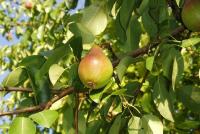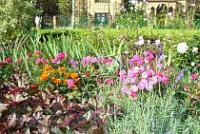How to keep the blue color of hydrangea flowers. Hydrangea - planting and care, growing in the garden.
Change the color of hydrangea
You may have heard that you can change the color of the hydrangea flowers by adjusting the pH of the soil.
But there are some nuances that do not depend on the acidity of the soil, let's take a closer look.
First, not all hydrangeas can be blue.
Hydrangeas with white or cream flowers such as Annabel can only be white or cream.
But sometimes they can become pink at the end of the season.
Hydrangeas that range from pink to blue and purple tend to belong to certain varieties of hydrangea known as mopheads and lacecaps.
These types of hydrangeas have an interesting opportunity to change the color based on the chemistry of the soil.
When grown in alkaline soil, the color is pink.
When grown in acidic soil, the color is blue.
The composition of the soil plays an important role on the color of hydrangeas, there are varieties such as Nikko Blue, Pretty in Pink, they all have almost equal chances to bloom in pink or blue depending on the soil they are planted on.
So remember that even if you buy hydrangea in bloom, you cannot be sure that it will bloom in your garden in the same color.
In order to control the color of the hydrangea, you need to manipulate your soil, the pH level and the mineral content.
But remember a sharp change in the pH of the soil can bring to the death of your plant.
It is necessary to change the level of soil pH gradually so as not to harm the plant.
You can get blue hydrangea flowers if the soil is at a pH of 5.2-5.5.
If the soil is alkaline, you can lower the pH by applying acidic organic mulch, such as pine needles or pine bark.
If you prefer pink flowers, your hydrangeas should be deprived of aluminum, growing it in alkaline soil with a pH of 6.0-6.2.
You can apply phosphate fertilizer to further hinder the absorption of aluminum.
Raise soil pH
Wood ash also increases soil pH.
It works much faster than lime and adds potassium to the soil.
But be careful when applying wood ash.
It is very focused, and applying too much can dramatically change the pH and cause imbalances in nutrients.
Lower soil pH
The soil can be more acidic by adding a soil acidifier, ammonium sulphate or aluminum sulphate.
You can lower the pH level by incorporating acidic organic materials such as pine needles, sawdust, peat and oak leaves.
Coffee grounds also slightly acidify the soil.
Varieties with blue buds
As a rule, these are large-leaved hydrangeas. They differ in rounded inflorescences, long and abundant flowering. Russian flower growers have seen large-leaved hydrangeas in potted varieties. Such cultures were not suitable for cultivation in open ground.
They just froze. And only much later were withdrawn. frost-resistant varieties. Which ones have blue flowers?
This is the most popular varieties. Many of them change color during one flowering period. Pink hydrangea can be bought, planting and care are provided in accordance with the requirements. And then the flowers turn blue.
This is a feature of the variety. We just did not pay attention to it. The color of the hydrangea changes easily. During the budding period, the bush should be watered with aluminum alum (two liters of water - a teaspoon with a slide).
Then the white color will turn blue, pink - lilac, purple or blue-blue.
Hydrangea Blue: landing and care
For planting are ideal seedlings of three-, four-year shrubs. It is better to buy them in specialized real or online stores. Root system seedlings should be protected and hidden in any material.
In the store for these purposes used containers.
Planting blue hydrangeas
Hydrangeas love penumbra. Open solar spaces do not like moisture-loving shrubs. In the shade, hydrangea blooms poorly, blooms later. For this plant you need a golden mean.
When planning group plantings, it is necessary to consider that space is required for the growth and development of the shrub. The optimum free diameter around each hydrangea is two meters.
Beautiful flowering shrubs love sour, moisture-consuming and loose soils. Provide similar conditions in the following ways:
- bring soil from the forest (you need to dig the ground under the pines along with needles); mix in equal quantities high-moor peat, leaf and sod land, sawdust compost, sand.
Hydrangeas do not like it when there is lime in the soil! Before last, dig a hole (width, length and height - half a meter). Pour in five buckets of water. The next day, make the prepared substrate, put a seedling, gently straighten the roots and cover them with earth.
Good water and cover with pine needles or peat.
Hydrangea blue: care
Decorative effect, color saturation, elasticity of leaves and shoots depend on proper watering, trimming, fertilizing. Hydrangea loves water. With a lack of moisture, it withers, bad blooms.
If you give a few buckets of water under such a plant, it immediately comes to life. The optimum frequency of irrigation is once or twice a week. Under each bush you need to give three or four buckets. If, after watering, mulch the soil around the hydrangeas, then water sufficiently every ten days.
Mulch will retain moisture longer. Conclusion: in no case should you allow the soil to dry around hydrangeas. The large-leaved blue hydrangea loves top dressing and responds very well to them. Fertilizers need to be depending on the period of plant development:
- at the end of spring - the first top dressing from superphosphate, potassium sulphide and urea (2: 2: 1,5); in the middle of summer (during the formation of inflorescences) - the second top dressing from superphosphate and potassium sulfide (2: 1); at the end of summer - the beginning of autumn (during the period of active flowering) - the third dressing, organic (compost or rotted manure).
To protect the hydrangea from diseases, it is recommended to periodically add any fungicide to the irrigation water (especially in the first year after planting). Conclusion: hydrangeas need mineral fertilizers; in the period of active flowering - organic. In no case can not bring ash! This is a mandatory step in the care of shrubs.
Regardless of the variety. Treelike, Grandiflora, paniculata, Japanese, hydrangea Phantom ... Planting and care will not be complete without pruning. Practically all varieties of large-leaved blue hydrangea bloom on the shoots of last year. This should be considered when pruning.
- in April, completely cut off a quarter of old shoots that are more than three years old; the rest - only last year's inflorescences; remove weak, diseased and overly exposed branches.
Conclusion: it is impossible to shred large-leaved hydrangea, as the inflorescences appear only on last year’s branches.
From the end of the summer actively water the plant. It should meet the winter quite strong. To prevent the shoots from mating under the shelter, treat the shrub with Bordeaux mixture.
At the end of October, when slight frosts are observed at night, hydrangea can be covered with perforated polyethylene or agrospan. At the beginning of November, tilt shoots to the ground, cover with spruce branches or dry leaves. And put the box on top.
Conclusion: blue hydrangea varieties are prepared for winter, like roses (reliably protect against frost).
Caring for Hydrangea is as follows:
- Periodic loosening soil to a depth of 5-7 cm, as well as the sprinkling of a new layer of mulch. Regular watering separated by warm water - so that the soil in the area of the roots does not dry out. Top dressing mineral or organic fertilizers twice a month. Creating supports for heavily overgrown bushes, so that the branches do not break under the weight of the inflorescences. Anti-aging pruning for old plants. Held in late October. Weak and old shoots are removed completely, and some - cut to 1-2 pairs of buds. Spring is also held trimming - remove the branches, frozen over the winter, and the young shoots shorten a little, stimulating the formation of new branches.
For lovers of indoor tropical plants Guzmania is a godsend. Juicy greens and bright spectacular flowers are all about her. Although it is not at all flowers, if you speak in a botanical language. Another visitor from the tropics is a room monster.
Incredibly large leaves and a rather exotic fruit make it interesting to grow in room conditions. See about it here. Can you make spiral compositions from indoor bamboo? Photos and instructions here - www.razmnojenie.ru/botanika/komnatnye-rasteniya/bambuk.html. By the way, properly done pruning allows you to create a standard tree from the Hydrangea bush - it will become the most original decoration of your site. This plant has a crown shaped as a small trees.
Breeding
As you see look after for the plant is easy. But the bush grows quickly, which means that you need to know how the plant propagates. The pancake Grandiflora has huge inflorescences!
- Seeds. This is a long process. The collected seeds are planted in open ground in late April-May. Grown from a seed plant will bloom only for 3 years of life. The division of the bush. If you divide Hydrangea in spring, by autumn a new bush will already take root completely. The division is allowed to produce and the winter, then young bushes need a reliable shelter. Green cutting, for what the cuttings of the current year are taken. Rooting will take 20-25 days.
The most convenient method of reproduction - green cuttings.
How garden Hydrangea winters
Looking at photo of garden hortensia, it is impossible not to admire her tenderness. Indeed, the main drawback of the plant is poor tolerance to low temperatures. So let's talk about wintering.
Due to severe frosts (below 18 degrees), flower buds on spring-formed annual shoots may die. It turns out that in the summer the bush will recover, but will not bloom. The hydrangea is a large-leaved, variety of Endless Summer. Of course, you can choose grade Hydrangeas, where the main decoration is the leaves, but in order to please you with magnificent inflorescences, the plant is always covered for the winter. Shelter for the winter for a tender hydrangea can be built, for example, like this.To not complicate the shelter of the plant for the winter, you can plant it from the very beginning in tub. It can be transferred to the greenhouse or basement, where there is no sub-zero temperatures.
Keep in mind that the most tender Hydrangeas - with pink flowers and their shelter should be especially careful, then the winter frost will not damage the delicate shoots.
Video
Very informative story about the types of hydrangea, the history of its cultivation, as well as the nuances of caring for different types.
What can go wrong?
Of course, Hortensia will fully decorate your garden if it blooms. But the questions about why the plant does not bloomThere may be different answers:
- Large-leaved Hydrangea may not bloom due to the fact that it is still too young. The root system may not develop well enough in young plants. The flowering may be disturbed due to non-compliance with pruning rules - the upper part of last year’s shoots cannot be trimmed. Laid buds can be damaged due to frosts. for a certain sort of climate. To avoid this, choose adapted to our climatic conditions.
Large-leaved with pink flowers. The most common diseases of hydrangea:
- chlorosis (lightening of the leaves) arises due to an excess of lime or humus; it is treated with a solution of nitric acid potassium or iron sulphate; downy mildew (looks like oil spots on the surface), occurs due to low temperatures (below +20) in combination with high humidity, is eliminated by a soap-copper mixture (150 grams of soap and 15 grams of copper sulphate per 10 liters of water).
As for insect pests, the spider mite and the green leaf aphid can live on the Hortensia. Pests are destroyed by spraying, for which a solution of thiophos (7 grams - 10 liters of water) or anabazine sulfate (20 grams - 10 liters of water) is prepared. The pedicle hydrangea is a climbing species.
Flower grower reviews
Nadezhda Smezhinskaya, accountant, 41: “For me, Hydrangea is impeccably beautiful. Her elegant hats are reminiscent of white foam. Some months they decorate my site, and grow in a shadow where other plants refuse to blossom.
Interestingly, the inflorescences bloom very slowly, so that I can enjoy its flowering. As for the care, I think Hortense unpretentious plant, although it needs to be watered regularly. ”Marina Kalyuzhna, a convinced summer resident, 48 years old:“ My beloved Hortensia resembles a long-lasting decorative bouquet.
I will tell you one secret - the rich color of flowers depends on the composition of the soil. So, if there is a high content of iron in the soil, the flowers will be purple or blue, and if not, they will remain pink. By the way, blue Hortensia blooms worse than usual white.
The good news is that the plant is undemanding in the care. In the middle of summer, my Hortensia pleases with huge flower balls, and therefore it is the best place on the site for photo shoots. ”Irina Lysenko, manager, 29 years old:“ My Hydrangea bush grew very quickly and already the next summer pleased me with huge snow-white hats of flowers.
Surprisingly, the bush wintered well under the elemental shelter of fallen leaves. AT next year I plan to divide the overgrown bush and begin to form a living hedge - imagine what a magnificent sight it will be in the summer. ”Olga Gerasimovna, retired, 63 years old:“ There is a little secret how to turn pink Hortensia into blue.
For this, aluminum salts (sulfur or sulfate) should be added to the soil. And if this is done unevenly, then inflorescences of different shades will appear simultaneously on one bush. ”Stanislav, a gardener with experience, 44 years old:“ Previously, the question of why Hortensia did not bloom was decided unequivocally — it was a bad winter. However, now, thanks to the breeding of cold-resistant varieties, such as vanilla frazes, endless summer, erly sensation, and others, flowering occurs on almost all young shoots, regardless of whether the kidneys are preserved during the winter or not. ”“ You can grow Hortensia not only in beds , but also in tubs or containers that can be easily moved to any place (to the garden, to the house or to the terrace and back). ”
Feedback and Comments
- Omaralez89 October 12, 2014, 11:17
I had to take care of the flowers at the parents' house while they were away abroad. Now I understand this much better than before, of course, not at the level of a professional gardener, but still.
I remember how, in early childhood, mother bought pots with blooming hydrangea. It was almost impossible to see leaves behind large pink inflorescences. In fact, these were “one-off” flowers: they bloomed and that was all, there was nowhere to plant them ... From capricious hydrangeas to more resistant onesOver time, the popularity of these wonderful flowers subsided. In the gardens, you could most often find large-leaved hydrangea with pink buds, which requires a lot of attention when grown outdoors. The fact that it blooms on last year's shoots that are not always possible to save.
It is necessary to cover well so that the apical shoots (on which flowers are formed) do not freeze over the winter. If it is unnecessary to cover it, they can support and there will be no flowering either. Well, if only by the end of the summer there will be several small inflorescences.
It is difficult to keep the golden mean ... Now there are many new varieties that do not require such careful care. I first bought a flower shop a few years ago, I was surprised by the color and shape of the inflorescences. A flat inflorescence with a single-row wreath of dazzling blue large flowers, and inside - a small placer in the form of underdeveloped flowers.
The second bush had inflorescences similar in shape, but with pink flowers, slightly smaller than the previous ones. And they were located not in one row of a wreath, but in the middle of the general background were still like blotches of blooming flowers.
In the third pot there were spherical inflorescences of dark beet color. The names of the varieties did not interest me then, and the sellers did not know them anyway ... When I transplanted the plants into large buckets and placed them at the entrance to the house, they showed themselves in all their beauty! By winter, the question arose: what to do with them next?
I had to plant in the open ground, sprinkle the roots with coniferous litter, bend down the shoots and wrap with spanbond. In spring, the shelter removed and slightly otgrebla mulch. Flowers appeared not only on old shoots, but also on newly growing ones.
It was an extraordinary sight! After that, I became infected with hydrangeas and, over time, gained experience in caring for them. I found out that this is a variety series called “Endless Summer”.
It is also called remontantnoy, i.e., it blooms both on last year’s sprouts and on this year. This series of hydrangeas is considered uncovered. Of course, you can not cover, but the flowering will be only on newly grown shoots, and this must wait.
So is it not better to cover and get longer flowering due to early flowering on old shoots and later - on new shoots? So it will endless summer. In addition to the varieties described above, it has acquired a terry blue Together. The bush is amazingly beautiful!
Each flower is individually small, but the inflorescence forms a large one. "Dolce Kiss" is also very beautiful, with reddish spots on the leaves. The inflorescences are flat, with a wreath of large flowers around the middle. And they are light pink, with red trim on the petals.
Magical Amethyst has petals on the edge of emerald green, and the middle of each flower is white. Magical Soglass, unlike the previous one, with a pink center, Magical Revolution - with red. In my collection of hydrangeas with red flowers, with red and white fringe at the edges of the petals, burgundy.
There are also two varieties of covering materials: serrated "Blue Bird" - with a light blue wreath and blue middle flowers and variegated with similar flowers, but with a pink middle. Red, blue, blue - choose any! Before planting in the open ground in a hole I pour around softwood buckets and aluminum sulphate, which contributes to the purchase of blue flowers. Color depends on the degree of soil acidity - from pink through lilac to blue.
Blue color gives not only acidity of the soil, as the presence of aluminum in it. To get a blue color, it is undesirable to make phosphorus-containing fertilizers and bone meal, but, on the contrary, more potassium. If you need a pink color, you can make superphosphate, which will prevent the entry of aluminum from the ground. I planted my hydrangeas in a “small area in front of the house on the north side along a low lattice fence. When all of them are covered with colorful hats of colors, there is no indifferent, they even come to specially admire this miracle.
Wintering Hydrangeas
Due to the fact that the hydrangeas are planted compactly, it is easy to cover them for the winter. After flowering, pruned inflorescences to a well-developed bud under inflorescence.
I try to save all the shoots - in the spring I’ll figure out what was freezing, what was rotting, what was breaking ... With the onset of frost, the leaves freeze, some of them fall down. If there are still leaves before the shelter, I cut them off with scissors.
I cover young low bushes with plastic vegetable boxes, higher ones bend down with low arcs. Those that are taller and more difficult to bend down are arcs from summer greenhouses.
Additionally, you can install on the end sides of the two racks on which to fix the rail in the form of a ridge above the roof of the house. This further partially relieves snow pressure.
From above I cover with a common “blanket” - a span-bond, and with the onset of frost I additionally throw in a film. The first time I keep the ends open for ventilation. Last year I had a good piece of padding polyester, I used it instead of a spunbond. She covered the top with a film, protecting it from getting too wet, but on all sides the edges were raised for a long time. The hydrangeas beneath the shelter were excellent. And although last winter a lot of snow fell, the shelter withstood the pressure and only a few shoots broke - they went to the cuttings. Read also: Hydrangea - growing and varieties
Hydrangea Fertilizer
Most often I use special dressings for hydrangeas, conifers, rhododendrons, as well as special colorizers for changing colors. In early summer, you can feed plants with nitrogen fertilizers, in summer - potash-phosphate fertilizers (see above - what color is desirable). For additional dressings I use herbal infusions: I take 1/3 chopped grass (dandelion, wormwood, celandine, etc.) for a 200-liter barrel .), I add copper and iron sulphate (1 tbsp. of spoon), boron and manganese (1 tsp.), a little less of a bottle of iodine, 100 g of "Baikal", 1 kg of chalk, 0.5 kg of sugar or jam, 1-2 buckets of humus.
All this wanders week, during which the mixture is periodically stirred. Then I grow 2 liters of infusion on a bucket of water and water everything that grows in the garden. Sediment spread under the bushes.
This infusion can also be sprayed. Very useful fertilizer - contains almost all the essential trace elements. During the season takes two refueling.
This infusion can be done in half size.
Reproduction of hydrangeas
I multiply hydrangeas mostly in summer. I cut cuttings with 2-3 pairs of leaves. Shoots take from the middle of the bush, where there are no buds of flower buds. I remove the lower pair with an oblique cut, departing from 1-1.5 cm from the lower buds.
Over the top I retreat 0.5-1 cm and make a straight cut. Leaf blades shorten by half. I powder the lower ends with a stimulant and plant it obliquely in loose soil with the addition of coniferous litter. Single cuttings can be covered with a 5-liter bottle without cork.
I water well and throw a piece of spunbond on the bottle, protecting the cuttings from bright light. They root well. With the awakening of the upper kidneys, the bottle can be removed and, if necessary, transplanted cuttings into a pot or a permanent place.
Hybrid varieties rooted much worse. Important: The older the hydrangea bush, the more water is needed (up to 2-3 buckets). Hortense loves water very much!
Watering should start from early spring, without waiting for the appearance of buds. Note To obtain a resistant blue color, it is necessary to bring soluble aluminum sulfate several times into the water during the summer (15 g per 4 l of water). Aluminum potassium alum can be used (30-40 g per bucket of water).
Some advise to use ordinary table vinegar. My friend, seeing the dried inflorescences of large-leaved hydrangea, was surprised by their color and asked how I could paint my bouquets so beautifully. She dried up a white tree hydrangea and did not get anything like that. I explained to her that these varieties of large-leaved hydrangea themselves retain such a variety of colors.
Pink, blue, white, mauve? What do you expect?
Hortensia have a reputation for chameleon, but not all species change color. Although many hydrangeas become mauve with age, if you have beautiful white fluffy inflorescences, you will not be able to change them to pink or blue. For pink or blue inflorescences, you need a large-flowered hydrangea, Hydrangea macrophylla.
You can control the color of your hydrangea. To do this, you do not need to become a chemist, you need to understand why hydrangeas change their color.
How to make hydrangea blue?
Hydrangeas turn blue in response to aluminum in the soil. This requires two conditions:
1. The pH of the soil should be slightly acidic (5.2-5.5).
First, perform a soil test to determine the existing pH. Adding aluminum sulphate to the soil will help lower its pH if necessary. Caution: Not all plants tolerate acidic soil, and nearby growing plants may suffer. Always follow the instructions on the packaging when adding to the soil.
2. Aluminum must be present in the soil.
If aluminum is in your soil and its pH is low, your hydrangeas are likely to be blue. But if you have only naturally acidic soil, you may need to add aluminum sulphate.
Fertilizer - Fertilizer with a high content of potassium and low phosphorus content will help maintain the blue color. Avoid superphosphate and bone meal, which are sometimes used for more flowering.
How to change the color of hydrangea to pink?
Hydrangeas turn pink when they are deprived of aluminum. This can be done as follows:
1. Add dolomitic lime (lime with magnesium oxide) to raise the soil pH to 6.0-6.5. In this period, hydrangeas cannot obtain aluminum from the soil, but they do not suffer due to the lack of other nutrients and chlorosis. You absolutely do not need to make the soil truly alkaline, as many mistakenly believe.
2. Grow hydrangeas in containers. Speaking seriously, in potting mixes that do not contain soil, aluminum is usually absent, so your hydrangeas have no chance of turning blue.
Fertilizer - Use fertilizer with a high phosphorus content, since phosphorus prevents hydrangeas from producing aluminum.
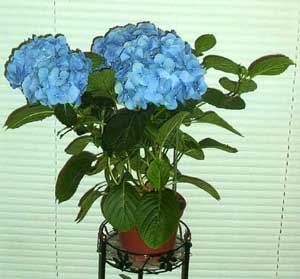
When your hydrangeas turn blue or pink, adding additional additives to the soil will not help increase the depth of color. Color may vary from season to season due to weather conditions, stress experienced by plants, and the environment. Plants planted near a concrete foundation or a concrete path may never turn blue due to lime, which is washed out of concrete.
Changing the soil for the color of hydrangea is not a one-time job. You will have to maintain the altered state of the soil.
The most interesting
Not all beginner growers know that the “natural”, natural color of hydrangea is white or pink. But other colors can be obtained artificially. And it is not difficult at all. At the very beginning of flowering, all its flowers have one color - pale green. It is at this stage that you can intervene to change its color. However, it should be noted that white flowers, due to lack of pigment, rarely change color. But with pink you can experiment successfully.
Many gardeners love the blue hydrangea, others prefer pink. But today we will talk about how to grow blue hydrangea. In nature and on flower beds, hydrangea reaches a height of up to three meters.
The color of spherical flowers captivates with its beauty. It so happens that you have purchased a blue or blue hydrangea, and a pink hydrangea has grown. Now we will share tips - what to do, so that all the same you have bloomed blue hydrangea.
Great value on the color of hydrangea has a soil composition.
If you work a little on changing the chemical indicators of the soil, you can easily change the color of these amazing colors.
Here are some tips on how to change the white color of the hydrangea to blue, and pink to lilac.
1. Before the flowering of hydrangea, water the plants with aluminum alum. Dosage -5 grams of alum per 1 liter of water. Iron salts, enriching the soil, give the colors of hydrangea shades from blue to blue.
2. With the same success, aluminum alum can be replaced with iron filings, or simply stick old nails into the ground next to a hydrangea bush.
Here you can change the color of gorgeous hydrangea balls with such simple methods.
Hortensia have a reputation for chameleon, but not all species change color. Although many hydrangeas become mauve with age, if you have beautiful white fluffy inflorescences, you will not be able to change them to pink or blue. For pink or blue inflorescences, you need a large-flowered hydrangea, Hydrangea macrophylla. In hydrangea, you can change the color (white to blue, and pink to blue). To this end, aluminum sulphate or iron is added to earth mixtures when transplanting plants - up to 15-20 g per 1 kg of soil.
What's better? Aluminum alum or aluminum sulphate? They write about iron, which does not always color.
To obtain blue flowers, water the pink hydrangea with a solution of potassium alum (5-10 grams per liter of water). If the same solution is watered with dark pink specimens, then the flowers will turn purple, and the red ones - purple. When using aluminum sulphate or iron, you can get a blue color. A good effect is obtained when spraying a solution of aluminum citrate (50 g. Per liter of water), once a week since the appearance of the buds. Also, the color may change when the soil pH is reduced to 4.5 (at a normal 5,5).
Meas pink color
Change to blue and blue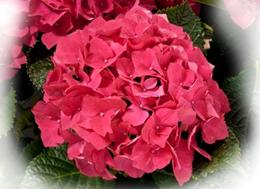
Hortensia will have pink flowers if it cannot form a blue pigment, for which aluminum is necessary. That is, the aluminum in the ground must be converted to a form inaccessible to plants. For this, the pH of the soil must be higher than 6.5.

To obtain blue hydrangea flowers, aluminum must be present in the soil in a form that is accessible to plants. This is possible in the case of an acidic reaction of the soil pH below 5.5 and the presence of a sufficient amount of aluminum itself.
If the pH of the soil in the garden is higher than 6.5, you do not need to do anything, the hydrangea will bloom pink (iron deficiency is possible).
On acidic soil, add chalk, lime fluff, ground limestone or dolomite flour several times a year to raise the pH to around 6.0 to 6.2 (be careful not to allow the pH to rise much higher than 6.5 when there is an iron deficiency and chlorosis will become a problem). Try to maintain the pH of the substrate from 6.0 to 6.2.
Do not plant near the pink hydrangea plants that require acidic reactions of the soil (azaleas, rhododendrons, heathers).
Use fertilizer with a relatively high content of phosphorus and nitrogen, but low in potassium. Phosphorus forms insoluble chemical compounds with aluminum. Choose a fertilizer type with an N: P: K ratio close to 25:10:10. Ammonium monophosphate can be used (11:53:00).
In areas with very acidic soils, pink hydrangeas are easier to grow in large pots using landless (for example, peaty) substrates in which there are few aluminum salts. In the peat substrate do not add components containing aluminosilicates - clay, mineral soil, expanded clay. The container will be much easier to maintain favorable conditions for growing pink hydrangeas, in addition, you can grow varieties that require shelter for the winter.
For the cultivation of pink hydrangeas the best choice is the substrate UNIVERSAL.
If the natural garden soil is sufficiently acidic, the pH is less than 5.5 and contains aluminum, the color of the hydrangea will automatically tend to shades of blue or purple.
. If the soil in the garden is neutral or alkaline, it is necessary to artificially acidify it in the root zone to a depth of 20-30 cm or replace the soil in the planting hole with previously prepared acidic soil. To acidify the non-carbonate soil to a pH of 5.0-5.5 can be high peat or agricultural elemental sulfur before planting hydrangeas. Subsequently, the low pH is maintained by regular watering of the plant with a solution (15 g / l) of aluminum sulphate during the entire growing season. Do not water dry soil, pre-moisten it well with clean water.
. Mulch the soil near the hydrangea with acidic materials - peat bog, coniferous bark. Do not use marble chips, expanded clay.
It is important that irrigation water does not "contaminate" the soil with calcium. The pH of the water should not be higher than 5.6.
. The alkalinity of the soil can rise significantly due to lime leached from building materials. Therefore, a concrete foundation or pavement, next to which a hydrangea is planted, can affect color.
Fertilizer also affects color change. Feeding with physiologically acidic complex fertilizers with low phosphorus content, high potassium content and medium nitrogen levels will help in producing a good blue color. The optimal N: P: K ratio is close to 10: 5: 20. Do not use superphosphate and bone meal.
. It is difficult for a long time to maintain a low pH value of alkaline carbonate soils, or soils contaminated with alkaline building materials. In this case, it is better to grow blue hydrangeas in large pots, using special acidic peat substrates with aluminum sulfate. In the substrate for the enrichment of aluminum, you can add 5-10% by volume of clay. The best choice The substrate will be acidic for coniferous plants and rhododendrons. The container will be much easier to maintain favorable conditions for the cultivation of blue hydrangeas, in addition, you can grow varieties that require shelter for the winter.
1.5 g / l of aluminum sulphate powder must be added per liter of acidic substrate. Stir well, moisten and stand for several days. Another way - plants in pots should be poured with a solution of aluminum sulfate (concentration of 10-15 g / l) at the rate of 100 ml of solution per liter of substrate. Control the pH of the substrate. For peat substrate the optimum pH value is 4.0-4.5. If necessary, repeat the procedure after two weeks. To avoid chemical burns of the roots, fill the aluminum sulphate solution with only a pre-moistened substrate. Keep leaves away from solution.
Hydrangeas will bloom with blue flowers (and not pink) if they are grown on acidic soil. Sometimes hydrangeas can change their color over time if the level of soil acidity changes. Therefore, if you want to constantly have blue flowers, you will need to monitor the pH of the soil and take measures to maintain its acidity. This is done quite easily - go to Step 1 to get started.
Steps
Part 1
Scientific backgroundPart 2
How to make the soil more acidic
Part 3
What to fear
- If you change your mind and want to return from blue to pink, apply dolomite lime or high phosphorus fertilizer to the soil. Do this regularly throughout the life of the plant.
- If the flowers of your hydrangea have a mixed color - pink and blue on one inflorescence, or purple, then the soil in your garden has a neutral reaction. To change the color of the flowers to completely blue, use aluminum sulphate, as described above, dissolving 1 tablespoon in 4.5 liters of water. Gradually, the color turns blue.
Warnings
- Unfortunately, it is not too easy to change the intensity of the colors of hydrangea flowers. Their brightness depends on many factors, such as temperature, humidity, general condition of the plant. Therefore, the only way to get bright beautiful flowers is to regularly feed the plant in order to maintain overall health.
Hydrangea blue - flowering garden shrub. He looks great in landscape compositions, suitable for decorating hedges, decorating arbors, paths. Currently, many varieties have been bred that easily tolerate the winter and delight with their flowering for many years. A separate type of "hydrangea blue" does not exist. This name was given to the plant for the shade of its flowers. Blue and blue buds covered varieties of hydrangea, mostly. There are two- and three-colored species that change their shade throughout the season. Today we will tell about the planting and care of blue hydrangea.
Hydrangea varieties with blue buds
As a rule, these are large-leaved hydrangeas. They differ in rounded inflorescences, long and abundant flowering. Initially, large-leaved hydrangea flower growers saw in pot varieties. Such cultures were not suitable for cultivation in the open field. They just froze. And only much later frost-resistant varieties were bred. Which ones have blue flowers?
- Hortensia "Mini Penny". Remontny grade. Blossoms on the shoots of the current year. It has lush green foliage and pale blue flowers, collected in spherical inflorescences.
- "Ramars". A small compact bush. Treats multi-colored grades. Some species are covered with purple or purple flowers. Others are spectacular bright blue with white.
- Freedom. Two color grade. At the beginning of flowering pink flowers appear on the background of rich greenery. Then their middle becomes blue, and the edges - white.
- "Compiteo". Hybrid variety with large lilac-blue flowers, the middle of which is white.
- "Perfheshn". Rose-like flowers are pink first. Then the shade changes to blue.
- Hopcorn Blue. A low bush up to sixty to eighty centimeters with tulip-like blue flowers. Blossoms on the shoots of the second year.
- "Jommar". Compact bush with blue terry flowers. Blooms also on the branches of the second year.
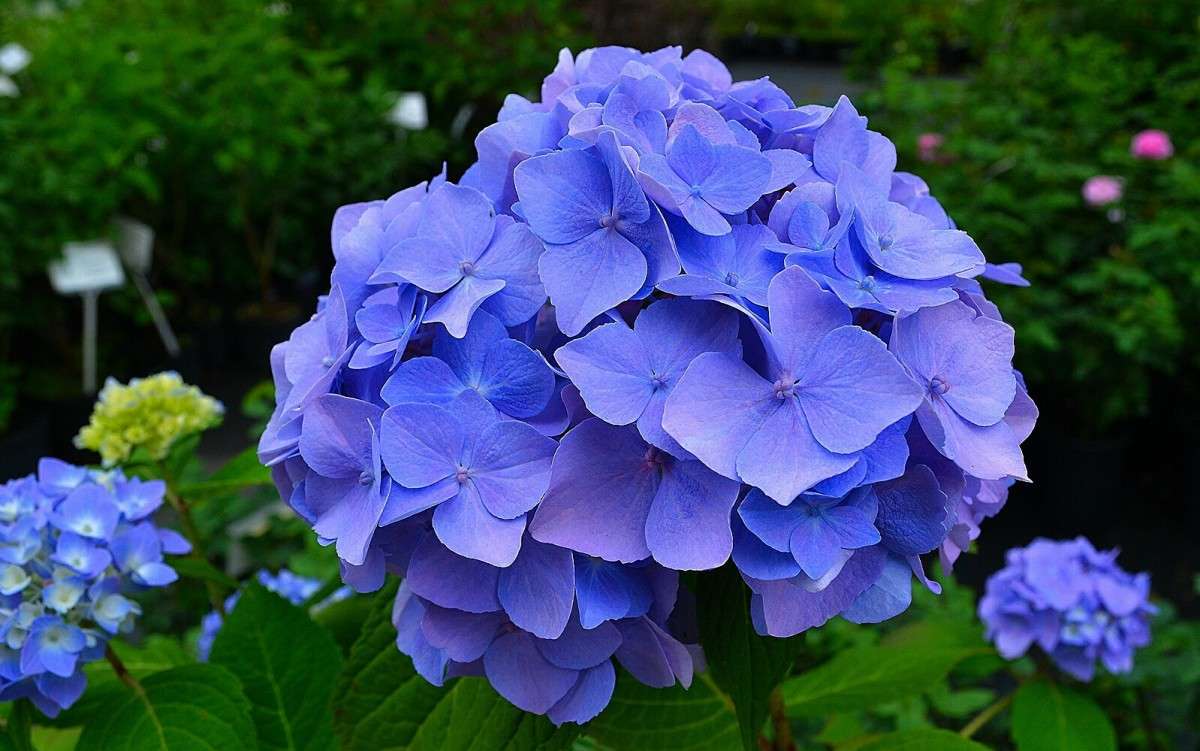
When to plant a blue hydrangea
The best time for planting a hydrangea is spring, the moment when the ground will thaw, the buds will not bloom yet, and autumn is in the month of September. When choosing a place for an ornamental deciduous plant, consider that it is better to plant the hydrangea in the shade or partial shade, as the bright sun causes slow growth, as a result of which the inflorescences shrink.
Preparing the soil for planting blue hydrangea
The soil for hydrangea should be well drained and hydrated, consist of a balanced mixture of humus, leaf soil, peat crumb, river sand (2: 2: 1: 1). Regardless of the type and variety of hydrangea, remember, lime in the soil adversely affects development. The soil should be with a Ph level of about 5.0. Alkaline soil leads to chlorosis (yellowing of the leaves). With the growth of a bush on alkaline soil, there is often a shortage of iron and magnesium, which is manifested by a light and pale color of leaves. Therefore, acidify the soil or treat the bush with iron chelate. In past centuries, gardeners have buried iron objects (nails, jar, horseshoe). When planting, they prepare a special balanced soil mixture with fertilizers.
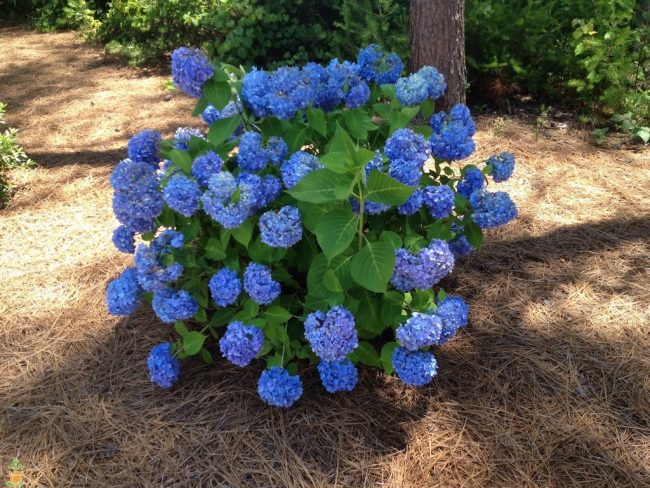
Planting blue hydrangea in open ground
Empty landing pit must be carefully shed water. The surrounding soil should be saturated with moisture. To do this, pour at least 3 buckets of water into the pit. A day later, you can start planting plants. For planting, the amount of soil substrate needed to fill the pit is mixed. Dry mineral fertilizers are added to the specified soil composition (50 g of fertilizers per 1 plant) and mixed thoroughly. You can also use specialized fertilizers for hydrangeas. The landing pit is filled with a prepared soil substrate, slightly compacting it. In the center they make a hole the size of an earthen ball on the roots of a seedling. The shrub is set in the hole, the roots are added dropwise with earth. The earth around the bush is compacted with hands. If, after compaction, the landing pit is not sufficiently filled, a substrate is added on top. After planting, the blue hydrangea is well watered, so that the entire volume of soil in the pit is saturated with moisture. Following this, the soil is covered with a layer of mulch. It consists of crushed bark or sawdust deciduous trees. Soil mulching is necessary to preserve moisture in the soil.
When planting several hydrangea bushes, the distance between them should be at least 1 m. This is necessary so that the bushes, growing, do not overshadow each other. If you want to plant a hydrangea in a row, then you can dig a trench 90-110 cm wide. If you want to achieve earlier flowering, then when planting, dig holes closer together (70-80 cm), and after 2-3 years thin out the bushes with of necessity. Landing pit Depth - 36-45, width - 51-65 cm. The roots grow mainly in breadth, extend far beyond the crown. Planting depth The root neck should be at the level of the soil, a maximum of 2-3 cm below, otherwise the flower will develop poorly. Now that you know how to plant a hydrangea, you need to take care of the plant in a timely manner.
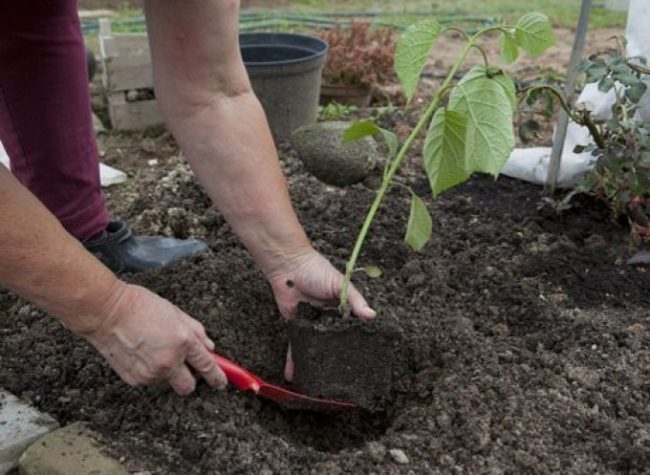
Care for blue hydrangea
Caring for hydrangea is weeding and loosening the soil around it, organizing a timely and proper irrigation regime. In addition, to prevent the rapid evaporation of moisture is recommended to mulch the bush in early summer, peat or sawdust.
In the fall, the plants are fed with complex fertilizers, and in the spring with urea (2 tablespoons per adult bush, dilute in 2 buckets of water and water). This allows them to develop and form large panicles.
During the growing season, the plant can be fertilized with slurry, but if you overdo it with organic dressings, then the branches of the bush may break off under the weight of the inflorescences.
Trimming Blue Hydrangea
It is important to properly form a shrub. Gardeners do not like to prune the branches, but in the case of hydrangea paniculata without a strong pruning you can not wait for abundant flowering.
Trimming rules:
- In the fall, cut off all the inflorescences.
- In the spring, all growing inside the bush, weak and frozen branches are cut out onto the ring.
- In the spring of one-year growth is shortened, leaving no more than five pairs of buds on each.
Such pruning contributes to the fact that every year the bush will bloom more magnificently. What does “abundant bloom” mean in the case of a hydrangea paniculata? A five-year copy with good care will please the host with a few dozen panicles, and a twelve-year-old with a few hundred! The plant lives in the garden for 50 years or more. A copy older than 20 years can be rejuvenated by cutting the bush on the stump. But even this pruning does not prevent the plant to bloom in the same year.

Protect blue hydrangea from pests
Blue hydrangea affects only aphid and red spider mite. These pests feed on plant sap and are able to reproduce in large quantities. Very often, the lack of control of them leads to the death of the plant.
- Leaf aphid accumulates on the tops of the shoots and petioles of the youngest leaves. Gradually multiplying, it sucks the sap of the plant, which leads to twisting and drying of the tips of the shoots. To help in the fight against them can only purchase insecticidal preparations for the destruction of aphids.
- Spider mite is a harmful arachnid. Ticks are very small and often not visible to the naked eye. You can see only the web on the youngest leaves of the plant. To combat this dangerous pest, there are drugs - acaricides and insect-acaricides, which destroy harmful arachnids.
Rest period of blue hydrangea
Novice growers may be concerned, noticing that the hydrangea leaves fall. If this happened in winter, there is no reason for excitement. The flower began a period of rest, which lasts about 3 months. Of course, it is difficult to recognize a blooming beauty in bare branches, but if you wait for the summer, you can be sure that this is the same beautiful blue hydrangea. How to care for the wintering flower? This process is very simple. Watering is significantly reduced, but the earthen clod cannot be allowed to dry. Fertilizing is not needed. Until March, hydrangea is cleaned in a cool dark place. Young plants, whose shoots are not woody, do not shed their leaves and hibernate without entering a state of rest.

